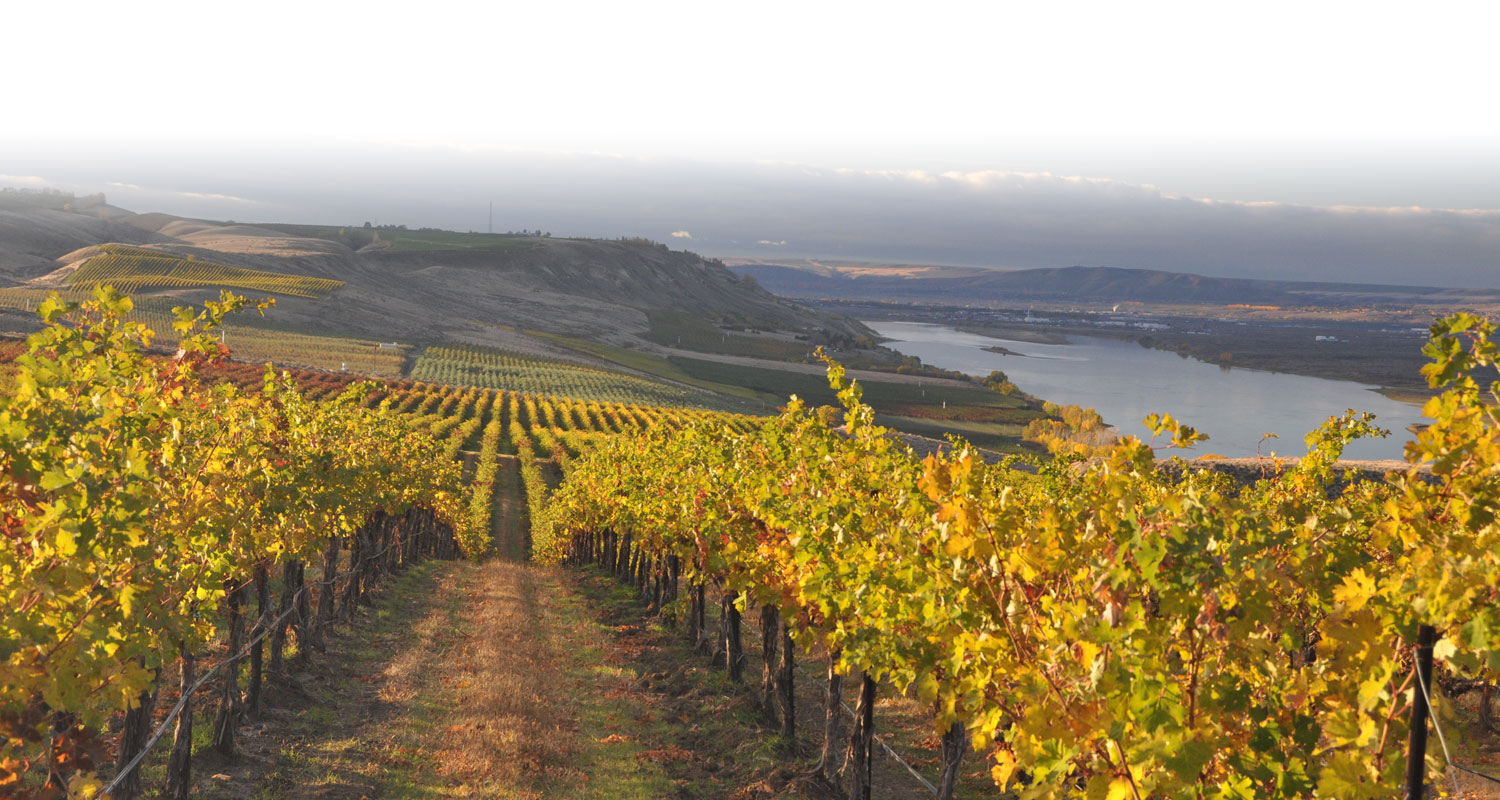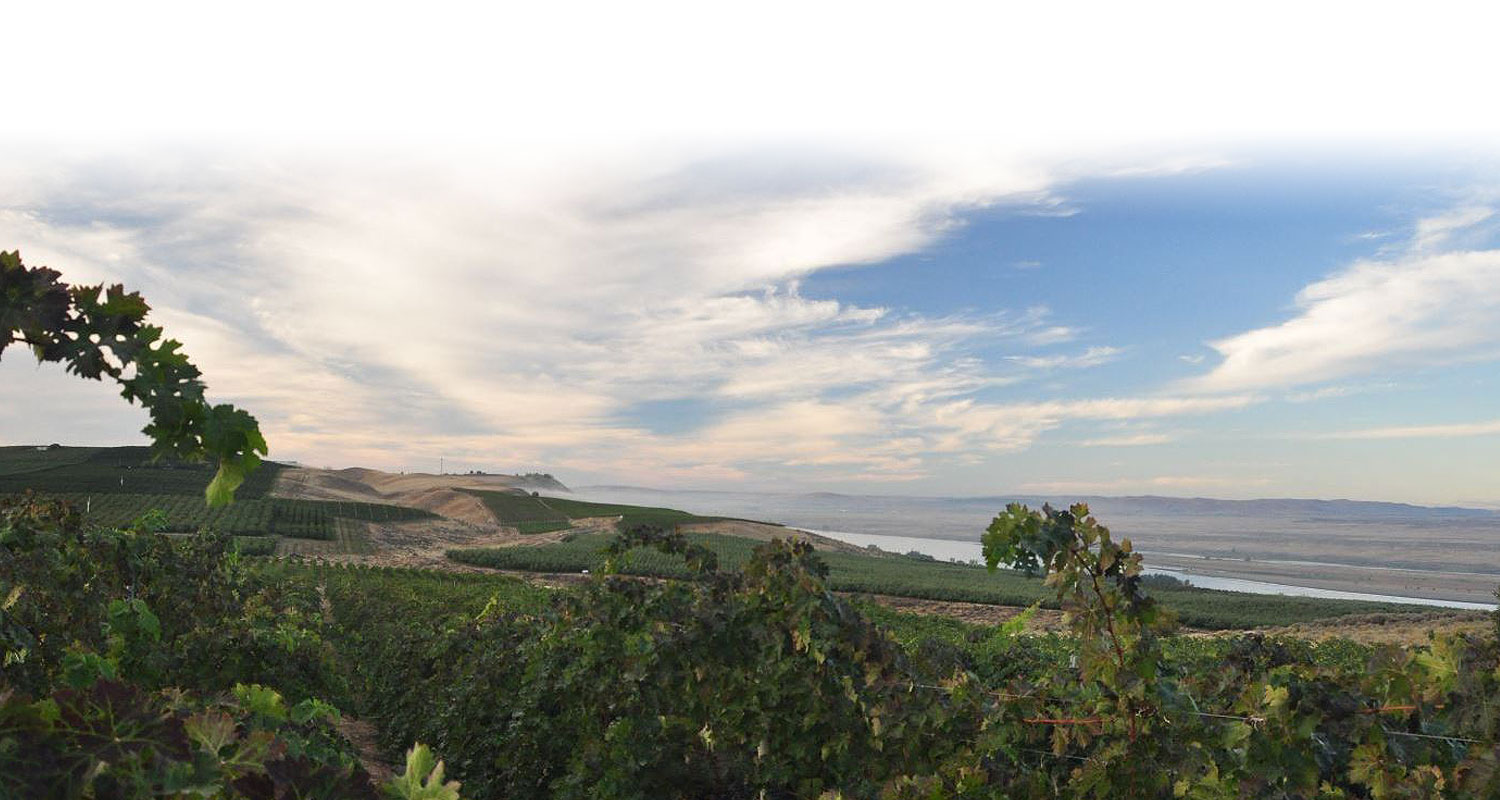Right Place, Right Time, Right Man: The 45-Year History of Sagemoor Vineyards.
By Emily Resling
The vineyards of Sagemoor are a proud collection of five distinct sites across the Columbia Valley.
Since the founders first planted vines in 1972, the idea was always to grow grapes and sell them to Washington’s preeminent wine makers. Never mind that they were unsure how to plant a vineyard. Never mind there was not yet an industry to speak of.
These were well-travelled men who’d caught the wine bug in their journeys. With little more to go on than a latitudinal line, they threw some stakes in the ground overlooking the mighty Columbia River 20 miles north of the town of Pasco, WA.
‘Flipping through the client list at Sagemoor is like reading nominations for a Washington wine hall of fame.‘
It helped that a good friend, who had a reputation for knowing such things, gave the land his stamp of approval for grape growing. That friend was Dr. Walter Clore, later immortalized by the State Legislature as the official “Father of Washington Wine.” So, the founders plowed ahead, planting more than 400 acres across three locations. A behemoth operation by the standards of the 1970s.
Of course, the Washington wine industry did grow (and grow, and grow). In 1984, the Columbia Valley AVA was officially established. In the 90s the Washington grape market surged. If you could grow it, someone would buy it. Back then the best you had to be was reliable.
But it wasn’t long before reliable stopped being enough. Toward the end of the 90s, consumer palates began a steadfast refinement that continues today. Winemaker practices matured, and some grape-growers found themselves in a precarious pivot. It was time to level up or get lost.

Tasting grapes in the vineyard during harvest season is a tough job…but somebody’s got to do it. Here, Kent Waliser and vineyard manager Lacey Lybeck sample grapes from a row of Merlot at Sagemoor’s Dionysus vineyard. (Photo by Ivory Leininger).
The First Few Decades
In its first few decades, Sagemoor had a strong reputation for being, at the very least, reliable. They showed up when they said they would with quality grapes by the ton. Located entirely within the Columbia Valley AVA, Sagemoor’s properties were blessed with vine-friendly soils and fortuitous climate conditions. In the early years, things were comfortable. They had a big customer who took 70% of the annual harvest.
However, the late 90s came and consumers wanted better than what the big customer was buying. So, the big customer went elsewhere. Things got a lot less comfortable. At the same time, winemaking hopefuls were establishing smaller shops around the state, and interest in Sagemoor’s potential grew dynamically.
The refinement of the American wine palate began in unfortunate tandem with a recession. The dot-com bust was tough on agriculture of all kinds. Ironically, the advancement of technology in business was growing too big to ignore. Widespread loss of income paired with necessary investments to evolve meant tough times had befallen Washington’s grape farmers. The path to survival, for some, included the costly move of ripping out wrong vines for the right ones. But everyone who hoped to survive had to learn a brand-new language and skill set.
The grape farmers weathering this particular set of growing pains were just barely getting some footing when the country suffered through 9/11 and greater recession woes arrived.
This was an important moment in the relevancy of Sagemoor to Washington’s grape-growing operations. Change was needed. Change to meet the higher standards of winemakers and the wine drinking public. Change to engage in the wine producing process with more awareness than the way things were done before. Change to step into the brave new technological world.
Kent Waliser’s Arrival

During harvest season, Kent Waliser’s most important piece of equipment is his cell phone, which keeps him connected to everything that’s happening at Sagemoor’s expansive network of vineyards on any particular day. (Photo by Ivory Leininger).
A daunting “Director of Operations” position at Sagemoor remained open for some time, despite plenty of professional interest. For Sagemoor, it had to be just the right fit. And then along came Kent Waliser.
If you ask around the chummy, tight-knit wine industry of Washington, there are many critical people, vintages, or bottlings that boosted Sagemoor’s visibility over time. But one name, a relative newcomer in the generations-old business, comes up time and again.
Born and raised in Milton-Freewater, OR. (home to sacrosanct vineyard The Rocks and its confusing geographical truths), Kent Waliser is an easy man to like. Standing 6’2” tall (“When I was 30.,” quips Waliser about his height. These days it’s a stretch”), he looks over a lot of heads. Rather than imposing, his vibe is warm and calm. He’s comfortable with eye contact and pauses before he speaks, suggesting an authentic thoughtfulness.
He arrived at Sagemoor in 2002 through a tumble of life events including a recent divorce, a weariness with the apple industry, a gut feeling, and a tour of cherry orchards and vineyards with a Sagemoor-employed friend.
Assuming operations of a 30-year old company during a recession and a tsunami of change can be reasonably intimidating. But Waliser, gazing upon original 1972 cabernet sauvignon vines, still flourishing since the founders’ first attempt, simply thought to himself “Well, this could be really cool.” And the next chapter — for both man and company — began.
“Before I got here, there were 30 years of history, very much aligned with the industry as a whole” Waliser says. “The wine business in America was changing in so many ways. Sagemoor intended to catch that wave and then I arrived and I got to catch it with them.”
Changes Were Made
Catch it he did. To begin, changes were made in the field. “No longer did we have one main customer plus a handful of others” Waliser explains. “We were approached by a new class of winemaker. Dozens of them. They wanted grapes a certain way — a silkier cabernet, a drier Riesling. They wanted to choose exactly which row their grapes came from, wanted to walk the actual land and pick their vines, so we arranged that.”

Harvesting grapes at Sagemoor Vineyards requires vine by vine, row by row precision by vineyard employees who take pride in the work they do. (Photo by Ivory Leininger).
An exciting genre of enologists was finally blooming in earnest in the northwest. They knew their viticulture, understood soil, could talk microclimates…and wanted to. “We were as interested in them as they were in us,” Waliser adds. ”
Over the next few vintages, Sagemoor grew a reputation as a great partner in wine project incubation. What’s your wine style? What are you hoping to accomplish? How can we help? Each answer focused the search for the right vineyard, blocks, and rows for a client’s vision. This is part of the field change that came with Waliser’s arrival. It’s still how things run today.
A mass exodus of the “old guard” wouldn’t surprise anyone after a transition like the one Waliser navigated the company through. Gone were the days of generic canopy management, uniform picking dates, shipping off bins full of grapes, never to be thought of again. New were the times of “A-Z listening and providing for customers” as Waliser describes it.
“Fortunately, I inherited a whole group of people who wanted to be part of that kind of service and relationship,” Waliser continues. “Historically, they didn’t have to think past raising the grapes and sending them off. But once we were able to really show why it matters, how raising grapes one way or another makes a difference, people got excited about applying their years of knowledge to vines they already understood incredibly well.”
Waliser saw very little change in his main vineyard crew. Together they saw a lot of change in their focus and their client list.
Waliser jokes that they have “100 bosses”, but it’s a line-up any wine professional could be so lucky to report to. The line-up includes Woodward Canyon’s Rick Small, Marie-Eve Gilla of Forgeron Cellars, Chris Peterson at Avennia, Abeja, J.Bookwalter, Mike Januik, Chris Sparkman, Anna Schafer at àMaurice, Chris Upchurch at DeLille Cellars, Ryan Crane of Kerloo Cellars, Allen Shoup of Long Shadows. Flipping through the client list at Sagemoor is like reading nominations for a Washington wine hall of fame.

Overlooking the mighty Columbia River, Sagemoor’s 150-acre Dionysus Vineyard grows grapes for approximately 50 Washington wineries. The gently rolling slopes of the vineyard (ranging in elevation from 600 to 900 feet) provide perfect growing conditions for Cabernet Sauvignon (the flagship crop of this vineyard) Chardonnay, Riesling, Merlot and Petit Verdot. (Photo by Ivory Leininger).
The vineyards of Sagemoor are five in number now, and in Waliser’s tenure each has seen a rising tide of recognition for the beautiful fruit they produce. Bacchus Vineyard, Dionysus Vineyard, Gamache Vineyard (acquired in 2016 from legendary brothers Gamache), and the eponymous Sagemoor Vineyard.
Each of these four is managed by a young pioneer, La Connor native Lacey Lybeck. “She’s the future of the industry” Waliser says. “She joined us because she was passionate and enthusiastic about the work we’d done here, about our history.
“It’s a huge job, and she stepped into it seamlessly” Waliser adds. “One day I’ll retire but this business will always evolve. Sagemoor will need to evolve. There isn’t a person better than Lacey to guide the company into its next iteration. I enjoy very much working with and learning from her.”
Lastly, the Sagemoor group of vineyards includes the Weinbau Vineyard on the cherished Wahluke Slope (a sub-AVA within Columbia Valley). Located on 460 acres 12 miles east of Mattawa, WA., Weinbau has been managed for over 30 years by Miguel Rodriguez, who earned the Erick Hanson Memorial Grower of the Year in 2005. “That’s especially sweet for us,” Waliser explains, “because the late Erick Hanson was our GM at Sagemoor Farms.”
In his spare time, Waliser likes to keep an eye on the future. He’s a hard-nosed believer that whatever your industry, you’ve got to give back. Sagemoor donates time, expertise, and grape tonnage every year to enology’s next generations at Walla Walla Community College, nearby neighbor Washington State University’s Wine Science Center in Richland, Washington and South Seattle Community College.
You’d think there’s been enough progress at Sagemoor…enough to keep a man busy, anyway. “Oh, we’ll see what’s next” Waliser says. “I always wanted to make my own wine with a Sagemoor label, working with a few of our great winemakers. I think that’s our next stop.”
Spoiler alert: It’s already in the bottle. Stay tuned to discoverwashingtonwine.com.



